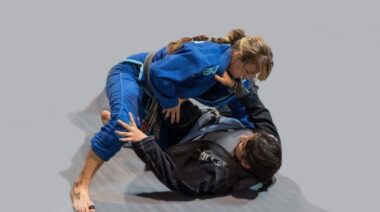Hands are good things in many contexts. We use them to drive, to type, to make contact with the people we love, to eat and drink, and to feel our way in the dark. That combination of wiggly fingers and opposable thumbs turns out to be highly useful in many athletic endeavors as well, whether we are wrapping them around a bar, gripping a bat/club/racket, or spiking a ball. For these and many other reasons, it’s no surprise that we lead with our hands in most everything we do.
In Brazilian jiu jitsu, however, hip movement is where it’s at, and in that context sometimes our penchant for leading with our hands can actually be a hindrance. When we grab with our hands, we may develop a false sense that we are secure or making progress, although hip placement, control, and movement are far more important. Further, in BJJ, as in many athletic endeavors, our power comes from our hips, not from pushing with our hands and arms. Thus, we want to maximize our own hip movement while shutting down that of our partners/opponents.
A fundamental movement pattern that helps practitioners learn the importance of using the hips is called, variously, the “shrimp,” the “elbow escape,” and the “hip escape.” It is called the “shrimp” because of the shape the body makes during one part of the movement. “Elbow escape” refers to the fact that during a training session the elbows are used to brace against an opponent to enable the hip movement in the opposite direction, but here we’ll refer to it as the “hip escape” to keep the focus on what we’re trying to do: create space with and for the hips to improve position relative to our partner. And if you want to learn how to do Brazilian jiu jitsu, you will find yourself doing this movement ad nauseam. Indeed, it’s likely that if high-level practitioners who have put in countless hours of training over multiple years added up all the ground they’ve covered over the years by hip escaping, they’d be talking some number of hundreds or thousands of miles.
Examples of situations where BJJ practitioners want to hip escape include when they are mounted (on their backs with an opponent on top of them who has one knee on either side of their hips – there’s that word again!) or when they are in side control (on their backs with an opponent on top, facing down and positioned generally perpendicularly to them). In these and other cases, the goal is to create space between one’s own hips and the opponent’s body, insert a knee or elbow, and eventually gain some control/containment over the opponent’s hips using the legs and feet.
So how does one actually perform a hip escape? I’m glad I asked! I’m not as glad I ended up being the talent in these pictures, though they show the basic hip escape drill that anyone can do without a partner. Of course, there are myriad variations incorporating partners and the like.
First, lie on your back with one leg bent, foot close to your butt. Keep your elbows close to your body. This position approximates how you might start out if under an opponent’s mount or in side control. You want to keep your elbows close; when they get separated from your body, they can be used for mischief and mayhem against you.

Second, push off of the bent leg, propelling your chest toward your knees and shifting your weight to your side, more specifically to your shoulder and your foot. See the shrimp shape? Also imagine an opponent on top or on the side. Your goal is to move yourself away from your opponent with this movement, not to move your opponent away from you. The movement will create space into which you can then insert a knee or a foot, which opens the path for you eventually to assert your own control over the other person’s hips, assuming all goes well. (Though this is frequently an optimistic assumption.)

Third, straighten your body out again and resume lying on your back. Put your other foot close to your butt. For the purposes of the drill, we hip escape in both directions, and it is this back and forth that enables us to rack up those frequent flyer miles as we move up and down the mat. We can also do the drill in a stationary fashion. In this case, we simply keep the foot we used to push off rooted to the spot and then use it to pull ourselves back to our starting position on the mat.

Fourth, we push off of the other foot and end up facing the opposite direction, in this case showing our best side.

There are many, many more details, uses, and situations related to the hip escape and to hip movement. This drill and this movement provide just a few of the fundamentals, and as you can see, anyone can do it any time. In this case, the journey of a thousand miles begins with a single shimmy.






